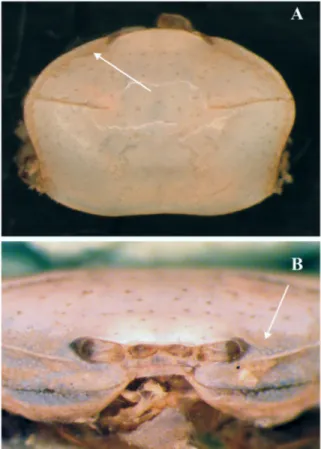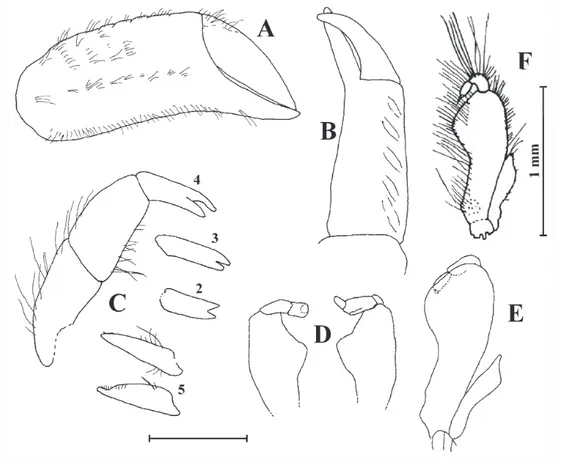New record of
Clypeasterophilus
stebbingi
(Rathbun, 1918)
(Decapoda: Brachyura: Pinnotheridae) from the east coast of
Nicaragua
Michel E. Hendrickx*and Francisco Solis
(MEH) Laboratorio de Invertebrados Bentónicos, Unidad Académica Mazatlán, Instituto de Ciencias del Mar y Limnología, Universidad Nacional Autónoma de México, P.O. Box 811, Mazatlán, Sinaloa 82000, México. Email: michel@ola.icmyl.unam.mx
(FS) Colección Nacional de Equinodermos “Dra. Ma. Elena Caso Muñoz”, Laboratorio de Sistemática y Ecología de Equinodermos, Instituto de Ciencias del Mar y Limonología, Universidad Nacional Autónoma de México. P.O. Box 70-305, 04510 México, D. F., Mexico.
* Corresponding author
A
BSTRACT -The pinnotherid crab Clypeasterophilusstebbingi (Rathbun, 1918),previously known from Florida, USA, Colombia and Brazil, is reported for the first time from Central America, on the east coast of Nicaragua. A single female specimen was collected on the sand dollar Clypeastersubdepressus (Gray, 1825), at 4 m depth, among turtle grass on sandy bottom. The specimen fits well with the description provided by M.J. Rathbun and observations made on photographs of the male holotype. Comparison of the material described from Florida (including the type material), Colombia and Brazil to the Nicaragua specimen, however, indicates that C. stebbingi shows some variation in the shape of the third maxil-liped.
Key words: Central America, Nicaragua, Pinnotherid crab, sand dollar
reviewed by Griffith (1987) who included all species known to him and revised new material available in collections (Department of Zoology, University of Toronto, Canada; USNM, Smithsonian Institution, Washington, and Museum of Comparative Zoology, Harvard University, USA). As a result of his study, three synonymies were established and three new species were described, totaling 13 valid species, six from the Pacific and seven from the Atlantic coasts of America (Griffith, 1987). As part of a general revision of the affinities within the family Pinnotheridae, species of the genus Dissodactylus were partly reassigned to Clypeasterophilus Campos, 1990 (Campos, 1990). Ng et al. (2008) listed 16 species of Dissodactylus, including six doubtful
I
NTRODUCTIONCrabs of the family Pinnotheridae are small species often associated with other marine organisms such as ascidians, mollusks, echinoderms and sometimes found in polychaetes, decapod crustaceans and fishes burrows (Warner, 1977; Brusca, 1980). Although it is not a general rule, there is a relatively high degree of specificity between the crabs (commonly known as “pea crabs”) and their host. Other species are free-living and there is a difficulty to estimate proportion of species for which hosts are not known (Warner, 1977; Melo, 1996). The genus
Dissodactylus Smith, 1870, was described to include species of Pinnotheridae specifically associated with Echinoidea. The genus was
species described by Aikawa (1933), and four species of Clypeasterophilus that had previously been included in the genus Dissodactylus.
Species of Clypeasterophilus are associated with sand dollars of the genus Clypeaster
Lamarck, 1801, and are distributed on both sides of America: Clypeasterophilus juvenilis (Bouvier, 1917), in Florida and Louisiana (USA), and the Bahamas, found on Clypeaster subdepressus (Gray, 1825); C. rugatus (Bouvier, 1917), in Florida (USA), Cuba, Mosquito Island, occurring on C. rosaceus (Linnaeus, 1758); C. stebbingi (Rathbun, 1918), in Flor-ida (USA), Colombia and Brazil, found on C. subdepressus; and C. ususfructus Griffith, 1987, along the west coast of Costa Rica and Mexico, collected on Clypeasterophilus (?) europacificus
H.L. Clark, 1914, and on C. speciosus Verrill, 1870 (Griffith, 1987; Werding and Sanchez, 1989; Hendrickx, 1990; Martins and D’Incao, 1996).
M
ATERIAL ANDM
ETHODSDuring sampling operation along the east coast of Nicaragua, specimens of Clypeaster
were collected and one specimen was found to be the host of a species of Pinnotheridae which is reported here. Abbreviations used are: CL, carapace length, CW, carapace width; EMU, Regional Collection of Marine Invertebrates, ICML, UNAM.
R
ESULTS ANDD
ISCUSSIONPinnotheridae
Clypeasterophilus stebbingi (Rathbun, 1918) Figs. 1-4
Dissodactylus stebbingi Rathbun, 1918: 123, fig. 69, pl. 28, figs 1, 2; Schmitt et al., 1973: 20; Powers, 1977: 121; Abele and Kim, 1986: 682 (key), 686, 687, fig. e; Griffith, 1987: 409, fig. 6; Werding and Sanchez, 1989:39, figs a-h.
Clypeasterophilus stebbingi.- Campos and Griffith, 1990: 553, fig. 1 C; Martins and D’Incao, 1996: 3, figs. 1, 14A; Ng et al., 2008: 248 (list).
Material examined: One female (CL 4.0 mm; CW, 5.4 mm), Woula Point (12°09’44.09’’ S, 83°04’21.80’’ W), Corn Island, east coast of Nicaragua, 13/March/2013, 4 m depth, among turtle grass, sandy bottom, on apical area of the sea urchin Clypeaster subdepressus (EMU-9799).
Additional material examined: Male holotype (USNM 49232), Sarasota Bay, Florida (USA). Photographs and some direct observations (courtesy or R. Lemaitre, Smithsonian Institution, Washington D.C., USA). One specimen (USNM, 95600), Florida (USA). Direct observations (courtesy or R. Lemaitre, Smithsonian Institution, Washington D.C., USA).
Remarks: Dissodactylus stebbingi was described based on a single male collected in Sarasota Bay, Florida. The diagnosis of the holotype by Rathbun (1918: 123) fits well with the examined specimen: “antero-lateral margin a thin rim; dorsal ridges transverse, each covering one-third width of carapace; palp of outer maxilliped 3-jointed”. Examination of photographs of the male holotype (USNM 49232), poorly preserved and lacking pereiopods (Fig. 1), indicates that our material is similar in shape and features the typical transverse dorsal ridges covering one-third the width of carapace (Figs. 2A, 3A), and a bucal frame and frontal area (Fig. 2B) that closely match the holotype (Fig. 1B). The figure of the third (left) maxilliped provided by Rathbun (1918: fig. 69), however, differs slightly from the Nicaraguan specimen (compare Fig. 4E to Fig. 4D) in its general shape (i.e., inner margin of distal part rounded in the holotype vs. triangle-shaped in the Nicaragua specimen) and in the relative size of the last three joints. The remaining third maxilliped (right) of the holotype, however, is still attached to the specimen (Fig. 1B) and appears very similar to the Nicaragua specimen (Fig. 2B).
illustrated, presumably taken from the material he reported from Florida. The general shape of the carapace, of pereiopods 4-5, the structure and proportions of the orbits and bucal area, and the female abdomen fit well with the Nicaraguan specimen (Figs. 2-4), although small differences are observed (e.g., relative size of distal cleft in dactyls of pereiopods 2 and 3), probably related to the angle at which drawings were made. As in the type material, the merus of the third maxilliped of Griffiths’ material is slightly different than in the examined female from Nicaragua. Also, Griffiths’ s illustration of the carapace in dorsal view failed to show the narrow frontal depression located next to each orbit and extending about half the distance between orbits and lateral margin; in our specimen (Fig. 2A, 3A), these narrow depressions bear minute tubercles. Close examination of the holotype of C. stebbingi
reveals the presence of these narrow frontal depressions (see Fig. 1A), and merely visible minute tubercles (direct observation by R. Lemaitre, pers. comm.). Another specimen identified as D. stebbingi and deposited at
the Smithsonian (USNM, 95600) was also observed and it features similar anterolateral depressions, also with what seems to be minute, merely visible tubercles (R. Lemaitre, pers. comm.). Werding and Sanchez (1989) reported and illustrated several specimens from Santa Marta, on the Caribbean coast of Colombia, collected on Clypeaster subdepressus. They describe the peculiar granular aspect of the lateral margins of the carapace but without providing an illustration of the third maxilliped. Martins and D’Incao (1996) have reported C. stebbingi from Brazil (São Paulo and Santa Catarina), with most specimens also
Figure 2. Clypeasterophilus stebbing (Rathbun, 1918). Female specimen from Nicaragua (EMU-9799) (CW 5.4 mm). (A) Dorsal view. (B) Frontal view, missing left third maxilliped. (C) Ventral view. Frontal depression indicated with an arrow. Scale bars: 2 mm.
Figure 3. Clypeasterophilus stebbing (Rathbun, 1918). Female specimen from Nicaragua (EMU-9799). (A) Carapace, dorsal. (B) Same, anterolateral part, detail. (C) Abdomen, ventral. Scale bar, 1mm.
collected from Clypeaster subdepressus (some specimens had no indication as far as host is concerned). Their illustration of a male also features minute granules distributed along the anterolateral portion of the carapace, and a small depression adjacent to the outer angle of each orbit, with minutes granules, is clearly observed on their illustration. The figure of a male third maxilliped provided by the same authors (Fig. 4F) is rather intermediate between Rathbun’s 1918 drawing and our illustration of the Nicaragua specimen, with an inner angle of the merus bluntly triangular rather than angular as in our material (Fig. 4D) or rounded as in the holotype (Fig. 4E).
Despite these differences, and based on the coincidences with the holotype (body shape, length of transverse ridges, presence of a frontal depression with tubercles), we are confident that the specimen collected in Nicaragua belongs to C. stebbingi, thus representing the first record of this species for central America and confirming its presence in the southern Caribbean province.
Acknowledgements - We thank José
Salgado-Barragán for taking and editing the pictures of the Nicaragua specimen, Rafael Lemaitre for the pictures of the holotype and the information related to the additional specimen held in the Smithsonian collection, Ernesto Campos and an anonymous reviewer for useful tips and literature, and Mercedes Cordero for producing the figures and the final edition of this manuscript. Thanks to Osmar Sandino and Shaungnessy Roshelle Quinn (Universidad Nacional Autónoma de Nicaragua, Departamento de Biología) for their help with the sampling of the material.
REFERENCES
Abele, L.G. and Kim, W. 1986. An illustrated guide to the marine decapod crustaceans of Florida. State of Florida Department of Environmental Regulation Technical Series. 8: 1-760.
Aikawa, H. 1933. On larval forms of some Brachyura.
2. A note on indeterminable zoeas. Records on
Oceanographic Works Japan, 5 (2): 124-254.
Brusca, R.C. 1980. Common Intertidal Invertebrates of the Gulf of California. 2nd Edition. University of Arizona Press, Tucson, USA, 513 p.
Campos, E. and Griffith, H. 1990. Clypeasterophilus, a new genus to receive the small-palped species of the Dissodactylus complex (Brachyura: Pinnotheridae). Journal of Crustacean Biology, 10(3): 550-553. Griffith, H. 1987. Taxonomy of the genus Dissodactylus
(Crustacea, Brachyura: Pinnotheridae) with descriptions of three new species. Bulletin of Marine Science, 40(3): 397-422.
Hendrickx, M.E. 1990. Range extensions and host record for Dissodactylusususfructus Griffith, 1987 (Crustacea: Brachyura: Pinnotheridae). Proceedings of the Biological Society of Washington, 103(1): 106-107.
Martins, S.T. S. and F. D’Incao. 1996. Os Pinnotheridae de Santa Catarina e Rio Grande Do Sul, Brasil
(Decapoda, Brachyura). Revista Brasileira de
Zoologia, 13(1): 1-26.
Melo, G.A.S. 1996. Manual de identificação dos Brachyura (Caranguejos e siris) do litoral brasileiro. Editora Pleiade e Fundação de Amparo à Pesquisa do Estado de São Paulo, São Paulo, 603 p.
Ng, K.L.; Guinot, D. and Davie, P.J.F. 2008. Systema Brachyurorum: Part I. An annotated checklist of extant brachyuran crabs of the world. The Raffles Bulletin of Zoology, Suppl. 17: 1-286.
Powers, L.W. 1977. A catalogue and bibliography of the crabs (Brachyura) of the Gulf of Mexico. Contributions in Marine Science, 20 (Suppl.): 1-190. Rathbun, M.J. 1918. The grapsoid crabs of America.
Bulletin of the U.S. National Museum, 87: 1-461. Schmitt, W.L., McCain, J.C. and Davidson, W.A. 1973.
Decapoda I. Brachyura I. Family Pinnotheridae. In: E.-H. Grunner & L.B. Holthuis (eds.). Crustaceorum Catalogus. Dr. W. Junk B.V.-Den Haag, 160 p. Warner, G.F. 1977. The biology of crabs. Van Nostrand
Reinhold Company, New York, 202 p.
Werding, B. and Sanchez, H. 1989. Pinnotherid crabs of the genus Dissodactylus Smith, 1870, associated with irregular sea urchins at the Caribbean coast of Colombia (Crustacea: Decapoda: Pinnotheridae). Zoologische Mededelingen, 63(4): 35-42.

